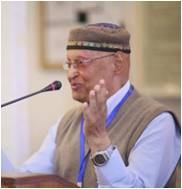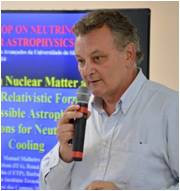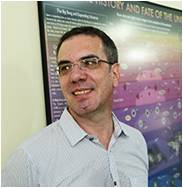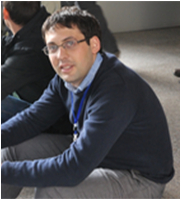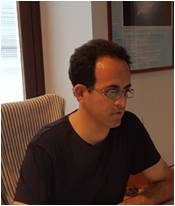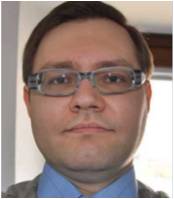

| Newsletter English July/September |

|

|





ICRANet Newsletter
ICRANet Newsletter
July - September 2016
SUMMARY
1. A new ICRANet center in Minsk 2. New collaboration agreements with Universities in Colombia 3. Professor Ruffini presents new results in Mexico, USA and Brazil 4. Recent publications 5. ICRANet participates in the European Researchers Night 6. Scientists visiting ICRANet
1. A new ICRANet center in Minsk
ICRANet and the National Academy of Sciences of Belarus (NASB) have decided to intensify their relationships of cooperation in international scientific research. On July 18 in Minsk, Belarus the signature of an annex to the cooperation agreement that tied them since September 2013 was signed at the meeting between prof. Vladimir Gusakov - the chairman of NASB presidium, prof. Sergei Kilin - vice chairman of NASB presidium, prof. Yuri Kurochkin - head of «Theoretical physics» center of the Stepanov institute of physics of NASB, Dr. Yuri Vyblyi - leading researcher in the laboratory of theoretical physics, and Prof. Remo Ruffini, director of ICRANet.

This new agreement establishes an ICRANet center in the capital of Belarus as an international academic center, that will host scientists and a staff of support. After Pescara, Rome, Nice, Rio de Janeiro and Yerevan the center of research led by Professor Ruffini also arrives in Belarus marking the opening to new scientific collaborations toward the Countries of Eastern Europe, Middle East and Central Asia. In addition to the new ICRANet center in Minsk the agreement of collaboration provides the intensification of the relationships between ICRANet and NASB and in particular the organization of further exchanges of scientific staff, schools, courses, workshop, lectures, exchanges within PhD and post-doc programs respectively in the areas of competence of this new international academic center. The multiyear collaboration with Belarus has led to the awarding of various PhD degrees of the IRAP PhD program to Belarusian students, as well as the nomination of prof. Gregory Vereshchagin the professor of the ICRANet faculty, and the organization of important international meetings: Zeldovich-95 meeting in 2009 and Zeldovich-100 meeting in 2014. The annex to the collaboration agreement can be found here.
2. New collaboration agreements with Universities in Colombia
The new agreement has been signed between ICRANet and Universidad de Antioquia - Colombia on September 20, by the Director of ICRANet, prof. Remo Ruffini and the Dean Faculty of Exact and Natural Sciences, prof. Nora E. Restrepo Sánchez.

The Agreement has, as its main objective, to regulate activities aimed at strengthening academic cooperation between UDEA and ICRANet. The activities to be developed within the scope of the present cooperation Agreement will consist of joint actions including: the institutional exchange of faculty members, researchers, graduate and post-graduate students; the development of teaching or research activities, related to the areas in which UDEA and ICRANet act; the organization of seminars, conferences, workshops or short courses in those areas; the support of technical- scientific and cultural events and activities open to the public; the development of opportunities to form university teachers and researchers, by means of specialized advanced high-level courses; the organization of training and recycling courses, and the development of inter-institutional research areas associated with local programs; joint publications; public conferences and other actions aiming at the popularization of science; exchange of information concerning teaching and research activities in each institution. For details see here.
3. Professor Ruffini presents an important result in a series of lectures in Mexico, Washington DC, and Brazil
Professor Remo Ruffini, Director of ICRANet, presented an epochal result at the Mexican Academy of Science and Arts of Mexico City, giving the opening lecture at the Sixth International Meeting Leopoldo Garcia – Colin.

This sixth meeting held from September 5 to 9, has been composed every day by a keynote plenary lecture and three parallel symposiums that focus on: a. Approaching black hole horizon; b. Quantum mechanics frontiers; c. Experiments in applied physics. In his opening lecture Professor Ruffini illustrated the results of the recent research of ICRANet on “Supernovae, Hypernovae e Binary Driven Hypernovae” and explained the concept of gravitational collapse of a neutron star companion induced by an exploding supernova (See Fig. 1 and Fig. 2), as well as the binary neutron star merging which is the subject of the publication in Astrophysical journal just announced today (see https://arxiv.org/abs/1607.02400v2): one of the most distant and complex system in our Universe (see the complete presentation at: http://www.icranet.org/ruffini-mexico and video on Youtube https://www.youtube.com/watch?v=qTzFUrkLNfE). 
The meeting illustrated, in the follows days, the Mexican participation of the Horizon Telescope and of the HAWC Observatory (see http://www.hawc-observatory.org) and moved to Gravitational Waves and Event Horizon Telescope (see http://www.eventhorizontelescope.org). 
Fig. 1: Scheme depicting the hypercritical accretion and the induced gravitational collapse in a binary system. The topic of Black Holes and Gravitational Lenses, as well as "supermassive" Black Holes and Sagittarius A, will be chaired by Scott M. Ransom of the National Radio Astronomy Observatory (NRAO, see https://www.nrao.edu) in USA. Other discussions have been: follow on: quantum mechanics frontiers, experiments on materials physics and applied physics, tissue engineering, soft matters, plasma polymerization, dark matter, relativistic compact objects, for a total of 80 contributions divided in three parallel seminar sessions. Professor Ruffini has also discussed with the Mexican colleagues and with the Ambassador of Italy, Alessandro Busacca, the selection of a Seat for the entrance of Mexico into ICRANet and the participation of Mexican students in the ICRANet coordinated IRAP-PhD (http://www.icranet.org/irap-phd). For details please see the press release. 
Fig. 2: Space-time diagram illustrating qualitatively the different stages of the sequence of events which occurs in a binary driven hypernova. On the 12th of September Professor Ruffini presented these new scientific results of ICRANet in the prestigious Cosmos Club in Washington DC (see https://www.cosmosclub.org) at the monthly meeting of the astrophysics working group. On the 13th of September he gave a colloquium in Rio de Janeiro at the CBPF (see http://www.cbpf.br), which hosts the ICRANet Seat in Brazil as a state Member. 
Fig. 3: Prof. Ruffini at the ICRANet Seat in Rome with ICRANet Faculty Members and IRAP-PhD students just after having obtained the results which led, among others, to this publication.
4. Recent publications
Professor Remo Ruffini announces a new publication of ICRANet scientists: “On the classification of GRBs and their occurrence rates”, posted online on September 9 (https://arxiv.org/abs/1602.02732) and currently in press in the prestigious Astrophysical Journal.
This follows by a few days the previous publication “GRB 090510: a genuine short-GRB from a binary neutron star coalescing into a Kerr-Newman black hole”, posted online on September 6 (https://arxiv.org/abs/1607.02400) and currently also in press in the prestigious Astrophysical Journal. GRBs have been traditionally considered to be single component systems characterized by relativistic jet emission and classified by their phenomenological properties into “short” GRBs, those lasting less than two seconds, and “long” GRBs, the remaining ones. The discovery of their cosmological origin and associated tremendous energies comparable to the energy emitted by the billions of galaxies in our past visible universe, each composed of 100 billion stars, did not modify this general simplistic approach: the origin of their energy was shrouded in mystery, although the general presence of a black hole in the system was often considered. 
Fig. 4: The interpretation of GRB observations within the BdHN model. In a series of papers over the past decade, scientists from ICRANet have developed a theoretical approach introducing the description of new fundamental physics processes, new astrophysical regimes and a series of new paradigms which have led to a comprehensive picture of GRBs, unique for its complexity and conceptual elegance. A different scenario has emerged: GRB progenitors, far from being single component systems, are in fact multiple component systems composed of a supernova and a neutron star companion, or of two merging binary neutron stars, or a binary composed of a neutron star and a white dwarf. These systems evolve in the merger process which may lead to the formation of a black hole and a newly born neutron star or to more massive newly born neutron stars. The understanding of the characteristic time of the gravitational collapse based on Einstein's theory of general relativity, the new physics, e.g. the hypercritical accretion pioneered in the 1970s by Ruffini, Wilson and Zel'dovich (see Fig. 4) and developed by ICRANet scientists, the splendid data obtained from the Agile, Swift, and Fermi satellites, and the contributions of the largest optical and radio telescopes worldwide, all have led to a novel classification of GRBs into seven different families presented in this publication (http://arxiv.org/abs/1602.02732). The class of “long” GRBs has been subdivided into "X-ray flashes (XRF)" and "binary driven hypernovae (BdHNe)". The class of "short" GRBs has been subdivided into "short gamma-ray flashes (S-GRF)", "short gamma-ray bursts (S-GRB)" and "ultra-short gamma-ray bursts (U-GRB)"; GRBs traditionally classified as "hybrid" are instead much better interpreted and classified as "gamma-ray flashes (GRF)". The theoretical description and distinguishing spectral and observational properties of each family has been presented. A progenitor system which originates within one family may later evolve and become itself a progenitor of a new GRB in a different family (see Fig. 5). It was also traditionally believed that each and every GRB originates from accretion in an already formed black hole system. Instead, in this new classification scheme, it is clear that only some of the GRB families imply the formation of a black hole, namely the most energetic ones (BdHNe, S-GRBs and U-GRBs). What is the most beautiful and outstanding aspect of the new understanding is that in these cases one can identify the moment of the formation of the black hole within the evolution of the GRB, and its activity can be observed in the precise moment of its formation. 
Fig. 5: Classification of GRBs into seven families.
For details please see the press release.
5. ICRANet participates in the European Researchers' Night

Also this year the Comune of Pescara, through Europe Direct, in collaboration the University “G. d’Annunzio” of Chieti-Pescara and ICRANet again organized “European Researchers' Night”. The event attracts over 1 million people every year and offers visitors a unique opportunity to meet researchers and take part in science activities aiming to showcase both the fascination of research as a career and its significant societal impact. The program of this event (in Italian) can be found here. During the morning the ICRANet center in Pescara has hosted more than 200 students of high schools. After the introduction by prof. Ruffini three lectures were delivered by Roberto Buonanno, Director of the observatory in Teramo, by Ana Virginia Penacchioni, the former PhD student of the IRAP PhD program, now post-doc at University of Siena, and by Marco Muccino, the Faculty member of ICRANet. These morning public lectures were followed by the public lectures at Aurum http://aurum.comune.pescara.it/ 

ICRANet center in Pescara was open for public and visitors were guided by profs. Belinski and Xue with the help of PhD students.
6. Scientists visiting ICRANet
During this summer several senior scientists visit ICRANet headquarters in Pescara: prof. Asghar Qadir (National University of Sciences and Technology, Iran), prof. Manuel Malheiro (Instituto Tecnológico de Aeronáutica, Brazil), prof. Hyung Won Lee (Inje University, South Korea), prof. Marcelo Guzzo (UNICAMP, Brazil), prof. Kim Sang Pyo (Kunsan National University, South Korea), prof. Narek Sahakyan (Director of the ICRANet seat in Yerevan, Armenia).
In addition, several young researchers visited ICRANet: Boshkayev Kuantay (Al-Farabi Kazakh National University, Kazakistan), Bakytzhan A. Zhami (Al-Farabi Kazakh National University, Kazakistan), Rashid Riahi (PhD student at the Isfahan University of Technology, Iran), Ivan Siutsou (Postdoc at CAPES - ICRANet program, Brazil), Soroush Shakeri (PhD Student at Isfahan University of Technology, Iran).
|
|||||||||||||
|
||
